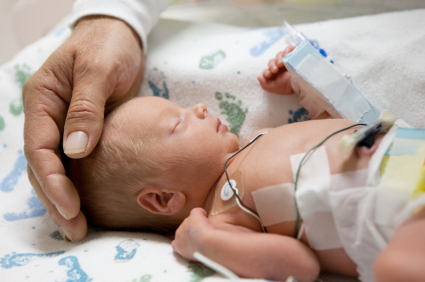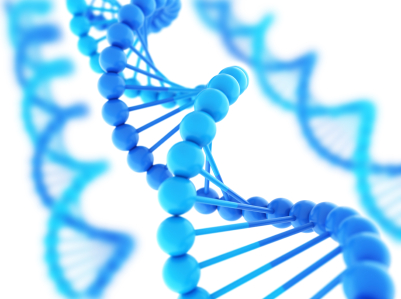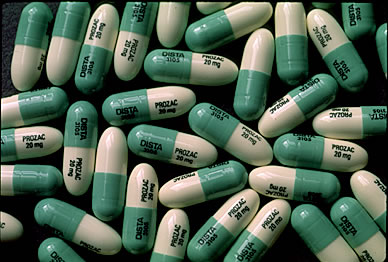Folic Acid Supplementation Not Linked To Cancer
 Folic acid is often recommended for patients with difficult-to-treat depression and for pregnant women. A recent study suggested that when taken before and in the first weeks of pregnancy, the vitamin supplement can reduce the risk of autism in the child. However, some concern was raised after a 2007 study that suggested a possible link between folic acid and cancer risk. New research indicates that cancer is not a risk of folic acid supplementation.
Folic acid is often recommended for patients with difficult-to-treat depression and for pregnant women. A recent study suggested that when taken before and in the first weeks of pregnancy, the vitamin supplement can reduce the risk of autism in the child. However, some concern was raised after a 2007 study that suggested a possible link between folic acid and cancer risk. New research indicates that cancer is not a risk of folic acid supplementation.
In a meta-analysis that analyzed data from 13 different trials of folic acid that included a total of over 49,000 patients, no increased risk of cancer was found in patients taking folic acid. The meta-analysis was published this year in the Lancet.
Editor’s Note: In addition to folic acid’s beneficial effects during pregnancy, it can also enhance the effects of antidepressants and mood stabilizers. The dose typically recommended for depression is 1mg for women and 2mg for men.
Fifteen percent of the population has an inefficient form of the enzyme methylenetetrahydrofolate reductase (MTHFR), which converts folate to methylfolate. For treatment of depression in these individuals, l-methylfolate should be used instead of regular folic acid.
Reminder: Multiple Risks for Fetus in Mothers Treated with Valproate
In pregnant women, exposure of the fetus to the anticonvulsant valproate (VPA or Depakote) is associated with a variety of serious problems that include congenital malformations, developmental delay, and autism.
The major congenital malformations that can result from valproate exposure include spina bifida, which results in lifelong paralysis of the child’s lower limbs.
Developmental delay resulting from valproate exposure can cause an average loss of 9 IQ points compared to children exposed to other anticonvulsant drugs in utero. The effects appear to be in part dose-related and dependent on the intensity of combination treatment with other agents. These deficits were originally seen in children at 3 years of age and were shown to persist in six-year-olds according to an article by Meador et al. this year in Lancet Neurology.
Now in addition, fetal exposure to valproate has been liked to autism and related disorders in an 11-year longitudinal study published this year in the Journal of Neurology, Neurosurgery and Psychiatry. A diagnosis of a developmental disorder occurred in 17% of children whose mothers were on valproate as opposed to 2% whose mothers were on carbamazepine and 7% whose mothers were on lamotrigine.
Neurologists are increasingly recommending that all women of childbearing age who are on a treatment regimen including valproate be treated with folic acid and vitamins B6 and B12, in the hopes that these might mitigate valproate’s effects on the fetus in the case of an unplanned pregnancy. The effectiveness of these vitamins has not been directly demonstrated. However, the study by Meador et al. did show that children of mothers who took prenatal folic acid supplements had IQs on average 7 point higher than children whose mothers did not. The benefit was seen only when mothers were already taking folic acid when they became pregnant and was not observed in children of mothers who began taking it after the first trimester.
Women of childbearing age should avoid valproate and if this is not possible, they should carefully protect themselves against an unwanted pregnancy. Women with bipolar disorder are 3.9 times more likely to have unplanned pregnancies than women of similar age in the general population. These data suggest the importance of careful education about birth control in patients with bipolar illness so that pregnancies can be planned for periods of good health and so that appropriate pharmacological measures can be taken.
Preterm Birth Is a Risk Factor for Bipolar Disorder
A study published in the Archives of General Psychiatry in 2012 sampled over one million births in Sweden and suggested that preterm birth (from 32 to 36 weeks) doubled the risk that a child would develop bipolar disorder later in life. Those born even earlier had a sevenfold increased risk for bipolar disorder.
Editor’s Note: A robust research literature indicates that schizophrenia is related to obstetrical and other pre- and perinatal medical problems. Now it seems bipolar disorder may be as well, with some caveats. Low Apgar score (which indicates difficulties at birth) and delayed growth were not found to relate to bipolar risk. Thus something about the shortened preterm development seems to convey the risk. The authors suggest that there may be different types of factors that predispose a person to develop bipolar disorder, and that in some people the illness may have development origins.
These data also fit with observations that only about 50% of patients with bipolar disorder have a positive family history of the illness. Thus, while bipolar disorder does run in families and has a strong genetic basis in many instances, there are many people who develop the illness without having this genetic/familial risk. Very preterm birth appears to be one other contributing risk factor, presumably among many others. Understanding the neurobiological mechanisms occurring before birth that mediate this risk may lead to direct preventive measures to lessen the risk. In the meantime, traditional measures supporting good maternal and fetal health are a good place to start. These include regular prenatal checkups, good nutrition, and prenatal vitamins that include high doses of folic acid.
Study of Twins Sheds Light on Epigenetic Mechanisms Implicated In Bipolar Disorder
At the 5th Biennial Conference of the International Society for Bipolar Disorders, H. Sugawara and colleagues reported on a particular example of epigenetics, an emerging field that studies ways that events and substances in the environment affect the structure of DNA. Often methyl or acetyl groups attach to DNA, making it easier or more difficult to transcribe. Sugawara’s group discussed hypermethylation of the serotonin transporter gene in bipolar disorder in an analysis of monozygotic twins discordant for bipolar disorder.
Monozygotic (identical) twins are highly concordant for bipolar disorder, meaning if one has the illness the other is likely to, but this does not occur 100% of the time. Thus, environmental or epigenetic mechanisms could account for the lack of genetic transmission of the illness in the odd cases in which one twin does not develop the illness.
Sugawara’s research group found that DNA hypermethylation of the allele encoding the serotonin transporter occurred in the twins with bipolar illness but not in those without. Once the expression of this particular gene had been identified as a difference between twins with and without bipolar disorder, the researchers examined the gene in non-twin patients with bipolar disorder compared to healthy controls and confirmed that people with bipolar disorder were more likely to have the hypermethylated allele.
The researchers believed that carrying a short form of the serotonin transporter was associated with DNA hypermethylation, and they went on to study the expression of mRNA for the transporter in bipolar patients carrying the short form of the allele. They found that DNA methylation was also higher at the serotonin transporter site in postmortem brains of bipolar patients.
Editor’s Note: This study provides one of the first insights into possible environmental mechanisms that explain why some people at risk for bipolar disorder develop the illness and others do not. Another possible mechanism for differential expression of the illness has been suggested by E.F. Torrey and colleagues, who believe that a viral infection may enter an individual’s genome and directly alter DNA sequences. The current data from Sugawara’s research group suggest the importance of further study of the serotonin transporter site in bipolar disorder and the mechanistic reasons for the DNA hypermethylation that occurs there.
Depression Associated with Increased DNA Methylation
Epigenetics is an emerging field where researchers are studying the ways environmental events and biochemical changes can affect the structure of DNA. Chemicals such as methyl groups can accumulate on DNA (a process called methylation), which usually results in suppression of genes in that area. DNA is tightly wound around proteins called histones, which can also be methylated or acetylated (when acetyl groups accumulate) based on events in the environment, including stressors and drug use. The environmental events do not change the genetic inheritance people receive from their parents, but instead change the ease with which genes are transcribed (or switched on).
At the 2012 meeting of the Society of Biological Psychiatry, Dr. Yurong Xin et al. presented an abstract that indicates that depressed patients may have much more DNA methylation at CpG sites on genes. CpG sites occur in many genes and refer to a place where a cytosine and a guanine (two of the four building blocks of DNA) sit next to each other on the same strand of DNA (the ‘p’ refers to the chemical bond between the two). CpG sites can become methylated. Xin and colleagues measured 27,578 CpG sites across 14,000 genes in the human genome. They found an eightfold increase in DNA methylation at these CpG sites in depressed patients compared to controls.
Editor’s Note: Previous research has found that early life experiences like psychosocial stress can lead to epigenetic changes. The new findings by Dr. Xin indicate that DNA methylation may occur and accumulate across the lifespan and suggests that DNA methylation may be associated with the emergence and progression of depression. Future treatments for depression could target this DNA hypermethylation, but determining how to do that selectively without affecting normal functioning may be a challenge.
Epigenetics Update
In the BNN we have previously written about the role of epigenetics in the onset and course of bipolar disorder. Epigenetics refers to the idea that events and substances in the environment can affect the structure of DNA by adding chemicals (often methyl or acetyl groups) onto DNA and histones (structures around which DNA is wound) in such a way that the DNA is more or less likely to be transcribed and activated to produce new proteins. Thus our DNA is shaped not only by the genetic inheritance we receive from our parents, but also by events in the environment (which do not alter the sequence of DNA but can influence how easily the DNA gets turned on to produce proteins in our bodies.)
Researcher David Sweatt published a review article on epigenetics and memory in the journal Neuropsychopharmacology in 2012. In it he examined research on rodents who show epigenetic changes after repeatedly being exposed to stimuli such as a fear-inducing environment or cocaine.
Sweatt made two main points abut the mechanisms by which the environment influences gene expression. The first is about the effects that histone deacetylase (HDAC) inhibitors can have on epigenetics. Contextual fear conditioning (when a rodent experiences danger in a particular place and begins to associate fear with that particular physical environment) can be augmented by histone deacetylase (HDAC) inhibitors, which include sodium butyrate and valproate. In rodents who have been given cocaine and whose interest in cocaine is associated with the physical environment they were in while receiving the cocaine, Marcelle Wood reported that extinction of this context-dependent cocaine-induced place preference could also be enhanced with an HDAC inhibitor.
Sweatt’s second point was that DNA methylation is necessary for long-term memory, and traumatic learning like that of the rodent avoiding the place it encountered danger can actually be erased using zebularine, an inhibitor of DNA methylation.
Editor’s Note: Zebularine can also reverse other lifelong responses to neonatal trauma such as decreases in brain-derived neurotrophic factor (BDNF), a neuroprotective factor necessary for long-term memory, in the prefrontal cortex. Zebularine can also block the long-lasting increases in motor activity in response to repeated cocaine use, i.e. cocaine sensitization. Thus, it looks like much of what one learns or responds to in the environment is coded at the level of epigenetics when DNA or histones are methylated and/or acetylated (among other chemical modifications).
Amazingly, some of these epigenetic marks on our DNA and histones can even be transmitted to the next generation! Read more
Lisdexamfetamine For Binge Eating Disorder
 Susan McElroy and colleagues are investigating whether lisdexamfetamine dimesylate (LDX) can treat binge eating. The research group carried out an 11-week blind randomized placebo-controlled trial of the drug at three different doses (30mg/day, 50mg/day, and 70mg/day). Patients taking the 50mg and 70mg doses of the drug performed significantly better than those taking placebo on most end points, including global improvement and reducing number of days binging. More of the patients taking those doses of lisdexamfetamine were able to achieve a 4-week cessation of binging. The researchers concluded that larger trials are warranted to confirm the drug’s efficacy and safety profile among binge eaters.
Susan McElroy and colleagues are investigating whether lisdexamfetamine dimesylate (LDX) can treat binge eating. The research group carried out an 11-week blind randomized placebo-controlled trial of the drug at three different doses (30mg/day, 50mg/day, and 70mg/day). Patients taking the 50mg and 70mg doses of the drug performed significantly better than those taking placebo on most end points, including global improvement and reducing number of days binging. More of the patients taking those doses of lisdexamfetamine were able to achieve a 4-week cessation of binging. The researchers concluded that larger trials are warranted to confirm the drug’s efficacy and safety profile among binge eaters.
Editors Note: The anticonvulsants topiramate and zonisamide have also shown efficacy in reducing the number and severity of binges in other placebo-controlled studies by McElroy et al.
Antiepileptic Drugs for Bipolar Disorder Do Not Increase Risk of Suicidal Behavior
![]() A 30-year observational study published by Andrew Leon and colleagues in the American Journal of Psychiatry has found that anticonvulsants used in epilepsy and for bipolar depression (carbamazepine, lamotrigine, and valproate) do not increase suicidal behavior in bipolar patients.
A 30-year observational study published by Andrew Leon and colleagues in the American Journal of Psychiatry has found that anticonvulsants used in epilepsy and for bipolar depression (carbamazepine, lamotrigine, and valproate) do not increase suicidal behavior in bipolar patients.
Editor’s Note: The FDA gave a warning in 2009 that these anticonvulsants were associated with suicidal ideation. This was based on studies of a mixed group of psychiatry and neurological patients in acute placebo-controlled studies, where suicidal ideation is typically a reason for exclusion from the study. Leon et al. used more powerful longitudinal methods to compare the risk of suicidal ideation in individuals taking and not taking anticonvulsants and found no such increase in suicidal behavior.
This is like the FDA warning for antidepressants and suicide, which was based on data from placebo-controlled clinical trials in acute depression (where suicidal patients are excluded). When investigators used the same longitudinal methods as Leon et al. in the anticonvulsant study, they found that antidepressants actually reduced suicidal behavior by 30%.
The bottom line is that the use of anticonvulsants for bipolar disorder should not be discouraged based on the FDA warning about suicidal ideation in mixed neurological and psychiatric patients. In bipolar patients, anticonvulsants do not increase the risk of suicidal behaviors, i.e. suicidal acts or completed suicides.
Despite the FDA Warning to the Contrary: Antidepressants Do Not Increase Suicidality
In 2007, the FDA began labeling antidepressants with a warning that patients aged 18-24 were at risk for increased suicidality during the first weeks of treatment. New evidence shows antidepressants actually have beneficial effects on suicide risk in adults. A study of all published and unpublished data on the SSRI fluoxetine (Prozac) and the SNRI venlafaxine (Effexor) published in 2012 by Gibbons et al. in the Archives of General Psychiatry showed that these antidepressants substantially reduced suicidal thoughts and behavior in adults and produced no increase in suicidal thoughts or behavior in children and adolescents.
The protective effect on suicidality in adults was mediated by mood, i.e. the patients’ mood improved and they became less suicidal. Children’s mood also improved on the antidepressants, but their risk of suicidal ideation did not change.
Editor’s Note: These are important findings. When the FDA box warning on antidepressants and suicidal ideation appeared, antidepressant treatment of youth decreased without an accompanying increase in psychotherapy, and the actual suicide rate in youth increased.
We now know that childhood-onset depression carries a bigger risk for a poor outcome in adulthood than adult-onset illness. In parallel, greater numbers of depressions are associated with more impairment, disability, cognitive dysfunction, medical comorbidities, treatment resistances, and neurobiological abnormalities.
It is important to treat illness in young people in order to prevent these difficulties, and the suicide warning should not deter the use of antidepressants. Patients should be careful about suicidal ideation in the first several months after starting an antidepressant, as other data suggest that this is a time of slightly increased risk of suicidal thoughts in children and adolescents.
Vitamin D3 Is Low In Children And Adolescents With Mania, But Supplements Help
Vitamin D3 is low in children and adolescents with mania, but taking a supplement could help. Vitamin D3, which we absorb via food and sunlight, is converted by the liver to a form called 25-OH-D. In a small study, Elif Sikoglu et al. found that children and teens with mania had lower levels of 25-OH-D in their blood compared to typically developing youth of similar ages. This deficit was associated with lower brain GABA levels measured with magnetic resonance spectroscopy. GABA dysfunction has been implicated in the manic phase of bipolar disorder. An 8-week trial of Vitamin D3 supplements significantly reduced manic symptoms and tended to increase GABA levels.
Editor’s Note: Other data have suggested that children with psychosis have low Vitamin D3, and in a recent clinical trial in adults, Vitamin D3 supplementation improved antidepressant response more than placebo. Many children in the US are Vitamin D deficient. Test them and, if necessary, treat them, especially if they have bipolar disorder.








